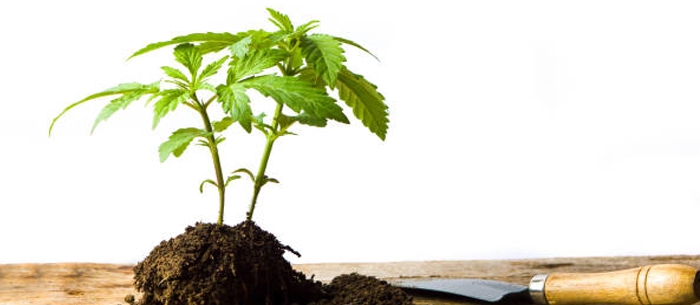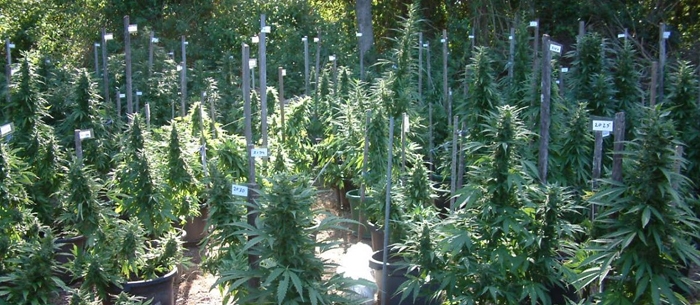When and How to Transplant Cannabis Plants
Transplanting cannabis is the process of moving a plant from one container to another, typically a larger one. Doing something wrong during this process can damage the already established root system. Delaying the transplant for too long can cause your roots to outgrow the container and become tangled. Some growers, especially those cultivating autoflowering strains, don't bother with transplanting and use the same pot throughout the entire cycle. So, what's the most optimal approach to transplanting when growing cannabis? Regular transplanting or complete rejection of this method? Let's find out.
Why is Transplanting Plants so Important?

When a plant is transplanted into a larger container, it gains access to a greater volume of fresh growing medium. Freedom, finally! Increasing the root mass facilitates efficient nutrient absorption and more vigorous vegetative growth, ultimately leading to better yields. Transplanting contributes to the health of the root zone, and having the right parameters of environmental conditions will undoubtedly yield a bountiful harvest of high-quality buds.
Key Factors to Consider When Transplanting Plants

Typically, cannabis growers prefer to start with small containers and then, as the plants develop, transplant them into larger pots (smart pots, air pots). If you are growing regular cannabis strains from seeds, you can transplant them into roomier pots after identifying and removing male plants. This approach can save a significant amount of space in your grow tent. Experienced gardeners also recommend transplanting when the young plant's foliage starts peeking out over the edge of the container (plastic cup or starter pot).
When purchasing cannabis seeds from the KADAMA online store, you can expect a 90% germination rate. Unfortunately, no one, not even reputable seed banks, can guarantee a 100% germination rate. That's just the way nature works. Long gone is the time when growers would plant a few extra seeds "just in case" – to increase the chances of getting more female plants. If you still do it, perhaps it's time to... consider changing your seed supplier?
One of the advantages of growing seedlings in small containers (often, these are solo cups) is the simple optimization of space. For some growers, this can be a significant factor. Admit it, it's easier to place, for example, five seedlings in a small heated tray that can be lit with a regular desk lamp than to struggle to find space for five 10-20-liter pots.
The transplanting strategy partly depends not only on the grower's circumstances but also on the available space they have. It's worth noting that each grower develops their own transplanting methodology that provides them with the best or most optimal results. Some growers transplant constantly, while others don't worry about it at all, preferring the simplicity of rooting plants in the final pot. Still, others adapt their approaches depending on the strain and genetics. Each of them can achieve excellent results. However, in certain circumstances, both transplanting and avoiding it can be either beneficial or undesirable.
When and How to Transplant Feminized Photoperiod Cannabis Strains?

Most growers prefer to periodically transplant young plants of feminized photoperiod cannabis. Unlike growing autoflowers, the clock isn't "ticking" here, and the end of the photoperiod isn’t set in stone. Thanks to this, the grower can gradually increase the pot size as the plant matures, keeping it in the vegetative stage. Refrain from transplanting plants if the soil is dry and loose. Such action will not only be ineffective but will inevitably lead to chunks of soil and roots falling off in the process. Make sure the soil is adequately moist so that when you remove the contents from the temporary container, it retains its structure and form. This way, the root mass will not be damaged or partially lost.
We recommend treating the root ball with mycorrhiza and/or adding it to the hole in the plant's next home. This promotes a symbiotic interaction between mycorrhiza and the cannabis root system, stimulating its active development. If you initially used a nutrient-poor soil for seedlings, you can gradually increase the nutrient content in the next containers to match the plant's increasing appetite as it grows. This approach guarantees that each subsequent container will be supplemented with the necessary nutrient components. When growing feminized seeds, avoid transplanting during the flowering stage. Allow the plant to allocate all its resources to flower formation, without subjecting it to potential stresses associated with re-potting (such as the loss and/or damage of roots).
When and How to Transplant Autoflowering Cannabis Strains?

Autoflowering cannabis strains have an intense but relatively short life cycle, which they complete in about 8-10 weeks on average. The vegetative stage "automatically" transitions to flowering after approximately 4 weeks from seed germination. Since autoflower genetics are programmed with tight timelines, many growers prefer to germinate their seeds in the final pot. This approach eliminates the risk of losing even a few days of growth due to stress from potential complications during transplanting. However, many autoflower enthusiasts achieve excellent results by planting seeds in small temporary containers and then carefully transplanting them into a permanent pot after a couple of weeks.
Useful Tip: When they are young and delicate, seedlings only need water. Excess nutrients in the soil can cause nutrient burn. At this stage, overfeeding can have devastating consequences. On the other hand, transplanting from a starter (temporary) container can be stressful, which can affect the seedling's growth rate, meaning a shorter vegetative period and a rapid transition to flowering. So, what should you do in this case? Here's a step-by-step life hack:
- Prepare the pot.
- Fill its bottom with drainage material (clay pebbles, gravel, perlite, zeolite, etc.).
- Fill it halfway with prepared soil mix, leaving some for topping up.
- Place a plastic cup inside the pot.
- Fill the soil mix around it until it's 2-3 cm below the pot's rim.
- Lightly compact it.
- Remove the plastic cup.
- In the resulting hole, amply sprinkle the walls with mycorrhiza.
- Fill the hole with rinsed, slightly moist inert medium (coco fiber).
- Carefully plant the germinated seed with the taproot facing down into the coco medium to a depth of 1-1.5 cm.
- Gently cover it with the same coco coir.
- Place the pot in the grow tent.
This approach ensures seedling growth and the development of its root system in an inert "lean" environment without getting any "hot" nutrients from the soil. It's only as the seedling grows and its roots emerge from the coco that the plant will start feasting on the nutrients that the soil is rich in, and these will be good for the plant when it's in a more mature state. When growing autoflowers, it is strongly recommended not to transplant during the flowering stage.
Can You Transplant a Plant Multiple Times?

Yes, but be cautious. Many growers usually don't rush with transplanting, preferring to ensure that the plant is ready for it. With experience, transplanting will become easier, without the risk of the root ball crumbling to pieces in your hands. However, if you still have doubts about whether you can do everything the right way when the crucial moment comes, you can practice on some vegetable crops (or even garden weeds) to gain skills, so your hands always remember the procedure.
What is the Root-Bound Condition?

If a plant's roots are confined in a tight space for an extended period, they start to lack both the necessary space and nutrients from the growing medium. You might see how the roots literally "twist" along the walls of the container, eventually tangling into a dense mass. It's important to understand that at this stage, the plant has already lost some of its potential, and efforts will be required to put it back on track. You'll need to manually untangle the roots before transplanting them into a more spacious container with sufficient fresh growing medium. Growing cannabis in small containers often results in smaller plants than what's achievable in larger containers. When growing cannabis in soil or, for example, coco coir, many gardeners prefer to use containers with a capacity of at least 10 liters (2.5 gallons). Usually, the larger the container, the better the yield, provided that optimal conditions are maintained, and other factors limiting growth are absent. But...
If the pot is excessively large, the short roots of the plant will struggle to reach nutrients in the farthest parts of the new spacious "dwelling." Additionally, plants grown in overly large pots are at risk of overwatering, over-fertilization, and, as a result, nutrient lockout and root rot. Therefore, transitioning from a 5-liter pot to a 10-liter one is more optimal and favorable for the plant than moving from a 5-liter to a 20-liter pot.
Transplant Stress, Its Symptoms, and How to Overcome It

Like other plants, cannabis can experience stress and shock due to unfavorable changes in its environment, including transplanting. Usually, an unsuccessful transplant involves damage to the root zone. In this case, the plant temporarily loses the ability to receive the necessary nutrients and water for growth, which can result in a slowdown for several days. Be patient and don't panic. During this time, the plant may look extremely discouraging. The reason is that, like a person moving to a new place, it needs time to settle in: let new roots form. Refrain from intensive watering/lighting/heat until the plant recovers.
Typical signs of transplant stress include:
- Lack of new shoots.
Seedlings concentrate all their biochemical activity on restoring the root system.
- Wilting even after watering.
Due to the compromised integrity of the root system, the plant cannot transport sufficient water.
- Yellowing of leaves.
- Reduced flower formation rates.
- Drooping leaves.
- Sensitivity to nutrients.
- Nutrient deficiency.
The plant regains strength to deliver and distribute them.
Choose Cannabis Seeds Wisely!
The seeds of cannabis with the most resilient and stable genetics typically exhibit enhanced vigor, allowing them to handle stress from transplantation or any other unpleasant events. Choose seeds wisely. Consultants at the KADAMA online store can help you select seeding material proven by the experience of the best breeders, meticulously tested to exclude genetics prone to stress. Don't try to save on seeds after you’ve invested so much in equipment, fertilizers, soil, or other medium. It's at this point that the pendulum of your comfort will swing either toward several months of relatively carefree cultivation or toward stress that both you and your plant will experience.
We wish you happy growing!
![[``]](/wa-data/public/site/themes/kadama/img/kadama_logo.svg)




